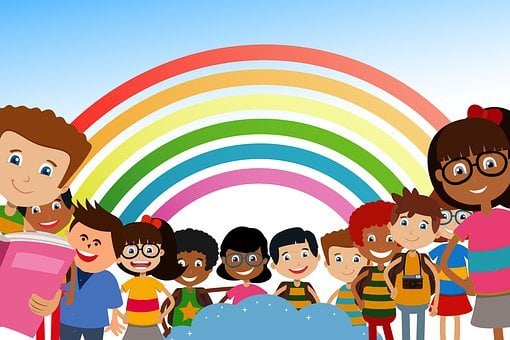How Cultural Influences Shape Child Development
 By recognizing the diverse cultural backgrounds from which children come, we can foster a more inclusive approach to education and caregiving, ultimately supporting the holistic #development of every child. Through this exploration, we aim to highlight the importance of #cultural-awareness in nurturing the next generation and ensuring their well-being in a multicultural society.
By recognizing the diverse cultural backgrounds from which children come, we can foster a more inclusive approach to education and caregiving, ultimately supporting the holistic #development of every child. Through this exploration, we aim to highlight the importance of #cultural-awareness in nurturing the next generation and ensuring their well-being in a multicultural society.
Cultural Influences on Child Development
Cultural influences on child development can be categorized into several key areas:
-
Self-Identity Formation: Children develop their self-image based on the cultural narratives they encounter. For instance, children from individualistic #cultures may describe themselves using personal attributes (e.g., "I am good at #math"), while those from collectivist cultures often define themselves in relation to others (e.g., "I am my mother's daughter"). This distinction underscores how cultural context shapes self-perception and identity.
-
Social Interactions: The way children learn to interact with others is heavily influenced by their cultural background. In collectivist cultures, cooperation and community are emphasized, #leading children to develop social skills that prioritize group harmony. Conversely, in individualistic cultures, assertiveness and competition are often encouraged, shaping children to be more self-reliant and independent.
-
Emotional Development: Cultural norms dictate how emotions are expressed and managed. Some cultures encourage open emotional expression, while others promote emotional restraint. This can affect how children understand and regulate their emotions, influencing their social behavior and relationships.
-
Language and Communication: The #language children are exposed to at #home significantly impacts their linguistic development. Bilingual children, for example, may have cognitive advantages and a broader understanding of cultural nuances. Furthermore, communication styles vary across cultures, affecting how children narrate experiences and engage in conversations.
-
Parental Influences: Parenting styles are often rooted in cultural values. For example, #parents from collectivist cultures may employ authoritative parenting techniques that emphasize obedience and respect for authority, while those from individualistic cultures may adopt more permissive styles that encourage independence and self-expression. These differences can lead to conflicts when children's home culture clashes with the dominant culture in educational settings.
-
Environ #mental Contexts: The broader environment, including community and societal structures, also #plays a crucial role in child development. Children from low-income or marginalized communities may face additional challenges that impact their development, such as exposure to environmental hazards or limited access to educational resources.
-
Media Influence: The media children consume can reinforce cultural stereotypes and shape their understanding of societal norms. Positive representation in media can enhance self-esteem and identity, while negative portrayals can lead to internalized biases and diminished self-worth.
Cultural Perspectives on Childhood
Cultural perspectives on childhood can be understood through several key dimensions:
-
Social Construction of Childhood: Childhood is viewed as a social construct that varies across different cultures and historical contexts. For example, the experiences of children in rural India can be vastly different from those in urban Japan or tribal communities in Africa. These differences reflect unique cultural values and economic realities, influencing how children are perceived and treated.
-
Collectivist vs. Individualistic Approaches:
-
Collectivist Cultures: In many Asian, African, and Latin American societies, children are raised with a focus on group harmony and family obligations. Key characteristics include:
- Family Connections: Children learn that their actions reflect on the family as a whole.
- Social Harmony: Emphasis is placed on avoiding conflict and maintaining group cohesion.
- Deference to Elders: Respect for authority figures is instilled from an #early age.
- Shared Responsibility: Children often take on caregiving roles and household tasks.
-
Individualistic Cultures: In contrast, Western societies prioritize personal achievement and self-expression. Characteristics include:
- Personal Achievement: Children are encouraged to develop their unique talents.
- Self-Expression: Individual opinions and identities are highly valued.
- Independence: Children are taught to make decisions and solve problems independently.
- Assertiveness: Standing up for oneself is encouraged.
-
-
Variations in Mother-Child Interactions: Cultural norms significantly influence mother-child interactions, which are foundational for attachment and socialization. For instance:
- Physical Contact: In many non-Western cultures, continuous physical contact is common, fostering strong bonds. Practices such as babywearing and co-sleeping are prevalent.
- Verbal Interaction: Western cultures often emphasize elaborate verbal exchanges, while in some non-Western cultures, non-verbal communication and observational learning are more common.
-
Educational Approaches: Educational practices reflect cultural values regarding learning and development. Differences include:
- Formal Education: Industrialized societies often prioritize academic knowledge and standardized curricula.
- Informal Learning: Traditional societies may focus on apprenticeship models, where children learn through participation in community activities.
-
Play and Childhood Activities: The nature of play varies across cultures, influenced by local values and resources. For example:
- Work-Play Integration: In agricultural communities, play often mimics adult work.
- Structured Play: Urban settings may have organized play with educational goals.
-
Rites of Passage: Cultures mark transitions in childhood through rituals that signify changes in status and responsibilities. Examples include:
- Birth Rituals: Ceremonies that welcome a child into the community.
- Educational Transitions: Events marking the beginning of formal learning.
- Puberty Rituals: Ceremonies that signify the transition to adolescence.
-
Impact of Globalization: Cultural perspectives on childhood are evolving due to globalization, leading to:
- Hybridization: Families blending traditional and modern child-rearing practices.
- Educational Convergence: Similarities in school systems worldwide.
- Media Influence: Exposure to global media shaping childhood experiences.
Child Development Across Cultures
Key Aspects of Child Development Across Cultures
-
Cultural Milestones:
- Developmental expectations vary widely among cultures. For instance, research shows that Jamaican mothers anticipate their children will walk earlier than Indian mothers, highlighting distinct cultural timelines for achieving #developmental skills such as walking, talking, and socializing.
-
Parenting Practices:
- Parenting styles are deeply influenced by cultural norms and values. Common styles include:
- Authoritative Parenting: Predominant in Western cultures, this style emphasizes independence, self-expression, and open communication.
- Authoritarian Parenting: More common in certain Asian and Latin American cultures, this approach prioritizes obedience, respect for authority, and conformity.
- These differing practices significantly shape children's emotional and social development, impacting their #mental- #health-and overall well-being.
- Parenting styles are deeply influenced by cultural norms and values. Common styles include:
-
Cultural Beliefs and Values:
- Cultural beliefs dictate parental perceptions of their roles and responsibilities. In collectivist societies, parenting often emphasizes community and familial interdependence, while individualistic cultures may prioritize personal autonomy and self-actualization.
- Parents frequently adhere to "cultural scripts," which are the unwritten rules and expectations guiding their child-rearing practices.
-
Impact of Acculturation:
- Immigrant families often experience shifts in parenting styles as they adapt to the norms of their host society. This acculturation process can lead to a blend of traditional and new parenting practices, affecting children's development in unique ways.
-
Variability in Childrearing Norms:
- Cultural norms influence not only parenting styles but also the behaviors that are encouraged or discouraged in children. For example, while some cultures may view physical discipline as normative, others may see it as harmful, leading to different outcomes in child behavior and #mental-health.
-
Universal vs. Culturally Specific Practices:
- While some parenting practices may appear universal, such as the need for nurturing and protection, the methods and meanings attached to these practices can vary significantly. For instance, eye contact may signify respect in some cultures but be interpreted as disrespectful in others.
-
Research Gaps:
- Despite the importance of cultural influences on child development, there remains a significant gap in research focusing on non-Western cultures. Most studies have historically centered on Western populations, leading to a limited understanding of diverse parenting practices and their implications for child development.
References
- https://pmc.ncbi.nlm.nih.gov/articles/PMC3799257/
- https://carijournals.org/journals/index.php/IJHSS/article/view/1783?srsltid=AfmBOopC-OYXJSSDLa_zo8EtRp5aEiHhpm-uvMMCdALh036LYlvTC8KW
- https://online.maryville.edu/blog/cultural-influences-on-child-development/
- https://www.childcareed.com/a/how-can-culture-affect-a-child-s-development.html
- https://theconversation.com/how-culture-influences-childrens-development-99791
- https://centreforearlychildhood.org/news-insights/guest-essays/cultural-diversity-and-the-social-and-emotional-development-of-young-children-in-early-childhood/
- https://www.zerotothree.org/resource/understanding-the-influence-of-culture-on-caregiving-practices-from-the-inside-out/
- https://novakdjokovicfoundation.org/the-role-of-culture-in-early-childhood-development/
- https://www.littleangelselc.com.au/how-culture-influences-on-child-development/
- https://psychologywriting.com/how-culture-influences-a-childs-development/
- https://dreamersnursery.com/how-culture-affects-child-development/
- Health, safety and nutrition
- Curriculum
- Professionalism
- Child development
- Family Child Care
- Website Articles
- Diversity, Equity, Inclusion
- Infant/ Toddler
- Preschool
- CDA
- Child development
- Curriculum and Environment
- Health, safety and nutrition
- Families
- Social/Emotional
- Content Areas
- Health and Safety
- Child Development
- Professionalism
- Training Guide for Families from Diverse Language and Cultural Backgrounds
- Diverse Perspectives in Child Care
- Grow with Me: Child Development for Mixed Ages
- Recognizing and Reporting Child Abuse and Neglect
- Strength in Differences: Cultural Diversity
- Understanding Montessori's Approach to Child Development
- 18-Hour Family Child Care Renewal Training
- 24 Hour Family Child Care Pre-Service Training ONLINE
- 45 hour Growth and Development Birth-age 12 ONLINE
- ACEs and Resilience in Child Care
- How Cultural Influences Shape Child Development
- How Can Culture Affect A Child’s Development?
- How motor skills shape child development and creative ways educators can foster them.
- CDA Certificate Made Simple: How to Earn Your Child Development Associate Credential
- Family Child Care/ Home Daycares Eligible for MD Child Scholarship Funding
- Child Care Professional Development
- Child Growth and Development
- 🌟Growing Strong: How to Track and Support Child Development in Young Children
- The Right Time to Get Your Child Development Associate Certification is NOW!
- How Can Online ECE Training Transform Your Understanding of Child Development?
- How Early Childhood Education Serves as a Pivotal Stage in a Child's Development
- Snow Much Fun: Winter Sensory Activities to Enhance Child Development
- Child Development Associate Certification
- Supporting child development through individualized learning.
- Big Snowflakes, Bigger Milestones: Supporting Child Development Through Seasonal Activities
- The Unofficial Guide to Acing the Child Development Associate Training: Humor & Hacks
- Goodbye Glitter Glue, Hello Growth: Child Development Milestones to Watch for in the New Year
- Texas providers looking for child development classes online?
- The Power of Play: How Play-Based Learning Shapes Development
- CDA Portfolio: Build a Winning Child Development Associate Portfolio


